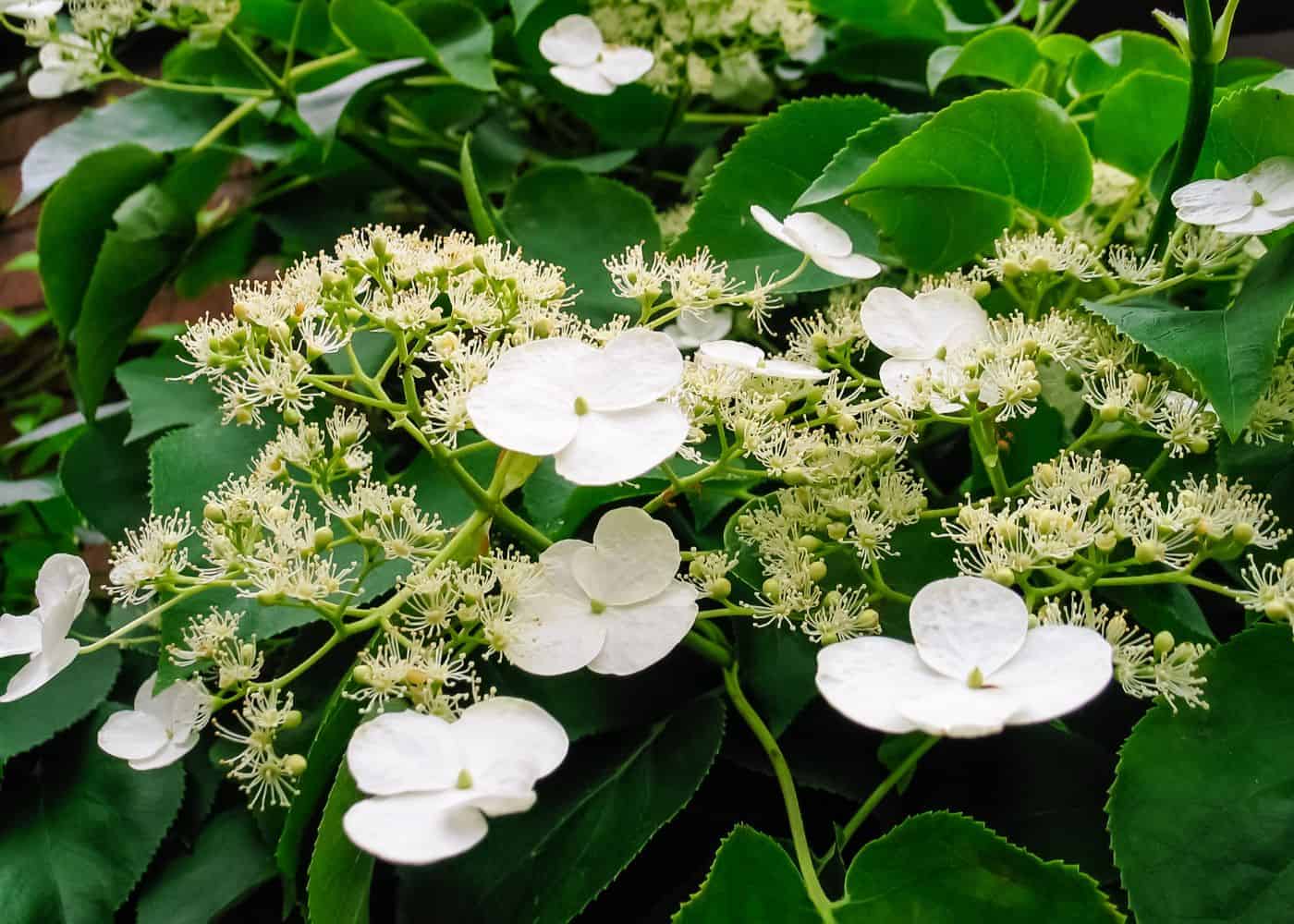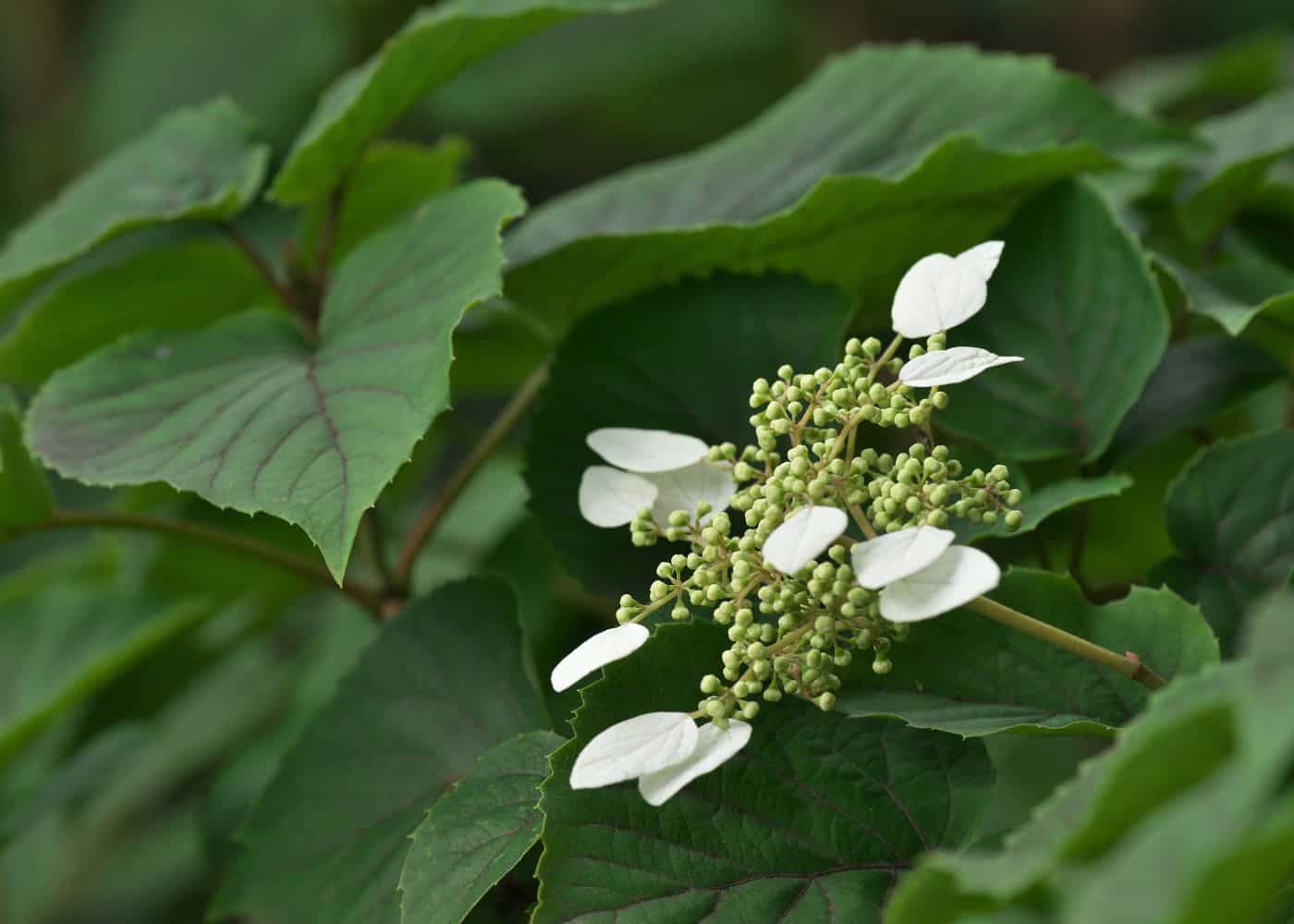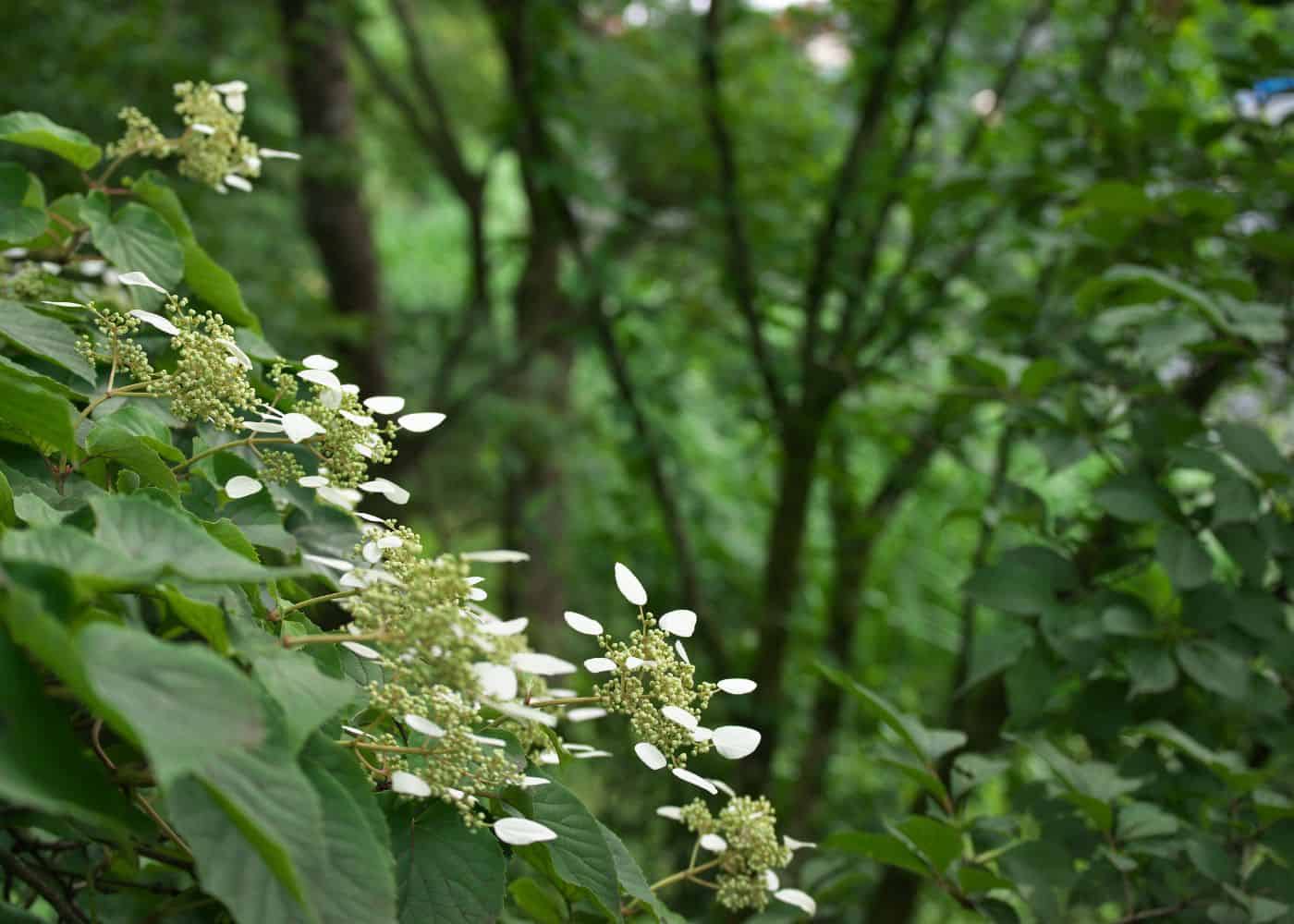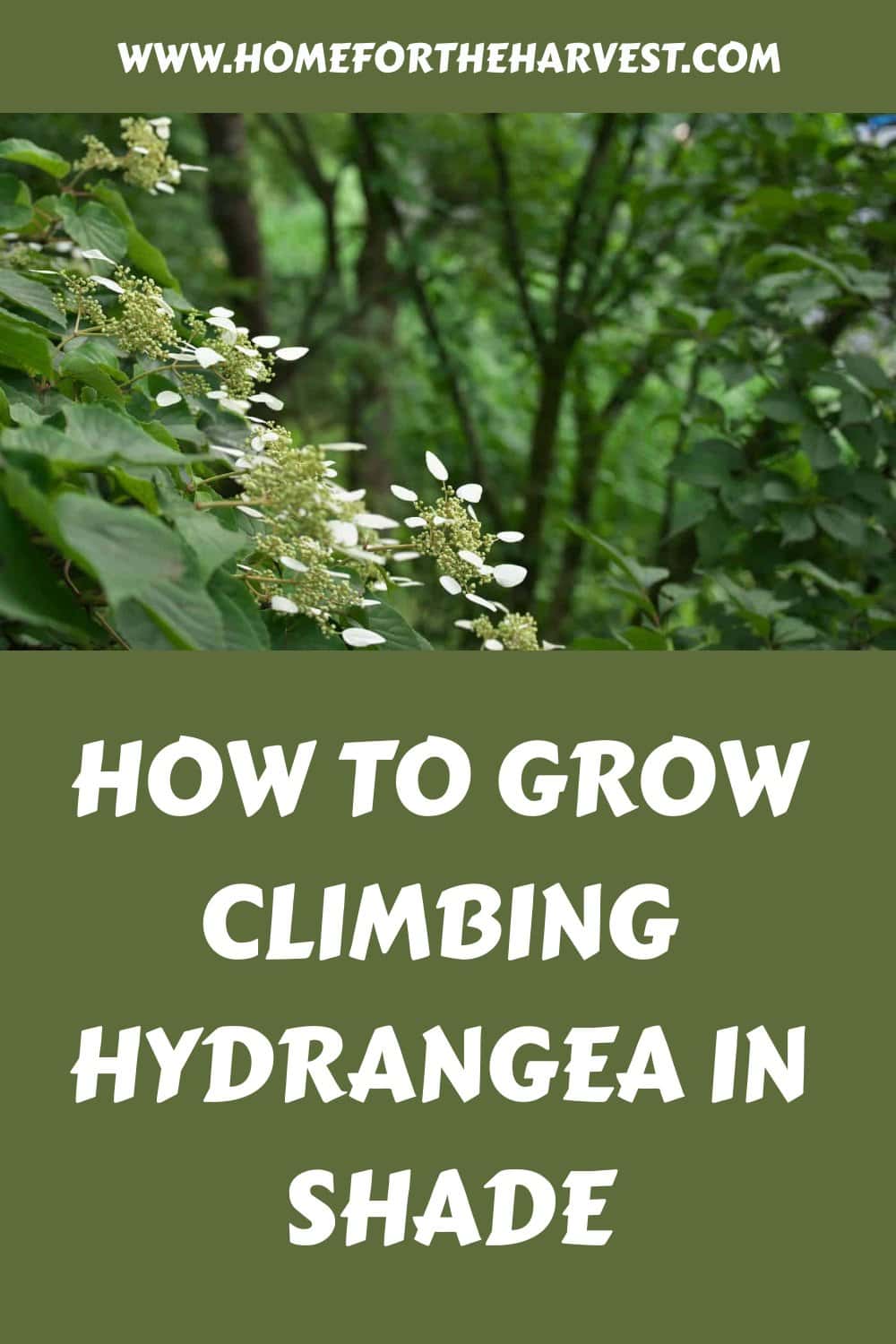Hydrangeas planted in the shade generally grow more slowly than those planted with a bit of direct sunlight but can still become large flowering vines. That said, afternoon shade is particularly welcome in hot climates or exposed areas. Look for a protected spot with good air circulation and train the young vine up a trellis to get it up off the ground.

Planting climbing hydrangeas in the shade
When planting climbing hydrangeas in shaded areas, there are a few important considerations to keep in mind. First, finding decent soil conditions for your plants is important. Hydrangeas prefer moist, well-draining soils with plenty of organic matter and a pH between 5.5 and 6.5. If you’re not sure what kind of soil you have, consider having it tested by a local nursery or garden center before planting your climbing hydrangea.
Next, make sure you plant your climbing hydrangea at the correct depth – this is typically just below the surface of the soil or slightly deeper if necessary. Be careful not to bury too deeply, as this can cause root rot and other issues down the line. When planting multiple plants together, space them evenly so they don’t compete for resources like water and nutrients from the soil.
Finally, when choosing where to place your climbing hydrangea in the shade, make sure that it has enough room to grow without being crowded by other plants or trees nearby – especially those that may cast too much shade on its leaves during peak hours of sunlight each day (usually mid-morning through late afternoon).
Caring for shade-grown hydrangeas
Watering and fertilizing climbing hydrangeas in shaded areas is essential for their health and growth. The amount of water needed depends on the soil type, climate, and season. In general, it’s best to water deeply once a week during the growing season. During hot weather or drought conditions, you may need to increase watering frequency.
Make sure to read product labels carefully when selecting a fertilizer. Most types of fertilizer should be applied in the spring before the plant blooms and then again in the summer as the blooms fade. Avoid using high-nitrogen fertilizers, as this can cause excessive leaf growth at the expense of flowers. Here is a guide to some great hydrangea fertilizers and how to use them.
When applying fertilizer, spread it evenly around the base of your plant but not too close to its stems or leaves, as this could burn them. Water thoroughly after application so that it reaches down into the root zone, where plants absorb nutrients from soil particles most efficiently.
It is also important to mulch around your climbing hydrangea to retain moisture and keep weeds away from its roots. If left unchecked, these weeds can compete with the hydrangea for resources such as sunlight and water. Mulching will also help insulate the roots against extreme temperatures, which can damage delicate foliage during both winter and summer months.
Pruning climbing hydrangea in shade
Pruning climbing hydrangeas in shaded areas is important to keeping the plant healthy and growing. Pruning should be done at least once a year, preferably in the mid-late summer after the blooms fade. This will help ensure that the shrub remains full and attractive throughout the season.
When pruning, it’s important to remove any dead or damaged branches first, as these can cause disease to spread quickly through the rest of the plant. Next, thin out overcrowded branches by removing some of them completely or cutting back their length. This will also help promote air circulation, which helps prevent fungal diseases from developing on foliage and flowers.
It is also important not to forget about shaping when pruning climbing hydrangeas in the shade. Try creating a pleasing silhouette by removing any errant shoots growing outside of their natural shape while leaving enough leaves on each branch so photosynthesis can occur properly without compromising overall health or vigor.

Common pests & diseases
The most common pests and diseases of climbing hydrangeas include aphids, spider mites, powdery mildew, and leaf spot.
Aphids are small insects that feed on the sap of plants. They can cause leaves to curl or discolor and stunt plant growth if left unchecked. To prevent an infestation of aphids, keep your climbing hydrangea well-watered and free from debris where the bugs could hide. If you do find an infestation, use insecticidal soap or neem oil to treat it safely without harming beneficial insects in your garden.
Spider mites are another pest that may affect climbing hydrangeas grown in shade. These tiny arachnids feed on the underside of leaves by sucking out their juices which causes them to become yellowed or spotted over time. To control spider mite populations, spray your plants with water every few days as this will help knock off any existing eggs or larvae before they hatch into adults. You can also apply horticultural oils directly onto affected areas for additional protection against these pests.
Powdery mildew is a fungal disease that affects many types of plants, including climbing hydrangeas grown in shade conditions where humidity levels tend to be higher than normal during summer months when temperatures drop at night. It appears as white patches on leaves, which eventually turn brown and die off, leaving behind dead spots all over the foliage and making it look unsightly.
Prevention is key here by avoiding overcrowding plants too close together since air circulation helps reduce chances for this fungus from taking hold. Plus, applying sulfur-based fungicides regularly should help combat it successfully if necessary.
Leaf spot is another fungal disease caused by excessive moisture around plant foliage leading to dark spots appearing along edges and then spreading further inward until the entire leaf turns black & falls off prematurely. Proper watering techniques, such as using drip irrigation instead of overhead sprinklers, plus pruning away infected branches & disposing them far away from other healthy specimens, can help minimize risk factors associated with this particular problem while keeping an eye out for symptoms just in case.
FAQs
What is the best hydrangea for shade?
The best hydrangea species for shade are bigleaf hydrangea (Hydrangea macrophylla), oakleaf hydrangea (Hydrangea quercifolia), and most species of climbing hydrangeas listed above. These varieties will usually grow best with a bit of direct sunlight, but usually only the gentle morning sun or in dappled late afternoon sunlight. Smooth hydrangea varieties and panicle hydrangeas (including most hydrangea trees) do best with 4-6 hours of direct sunlight per day.
Where is the best place to plant a climbing hydrangea?
The best place to plant a climbing hydrangea is in an area that receives partial sun or light shade. Morning sun is preferable to afternoon sun. This plant prefers moist, well-drained soil and does not do well in areas with full sun exposure during the heat of the day.
When planting the hydrangea, be sure to dig a hole twice as wide as the root ball and just as deep. Loosen any tight circling roots before adding your shrub to the hole and backfill with soil around it. Water thoroughly after planting and mulch around it for extra protection from extreme temperatures.
How fast does a climbing hydrangea grow in the shade?
While climbing hydrangeas usually grow about a foot per year, they typically grow much slower in the shade. Expect it to get off to a slow start for the first couple years. The plant will benefit from regular light pruning, which helps promote more vigorous growth and flowering. With proper care, you can expect your climbing hydrangea to reach its full potential within about 10 years in the shade.







